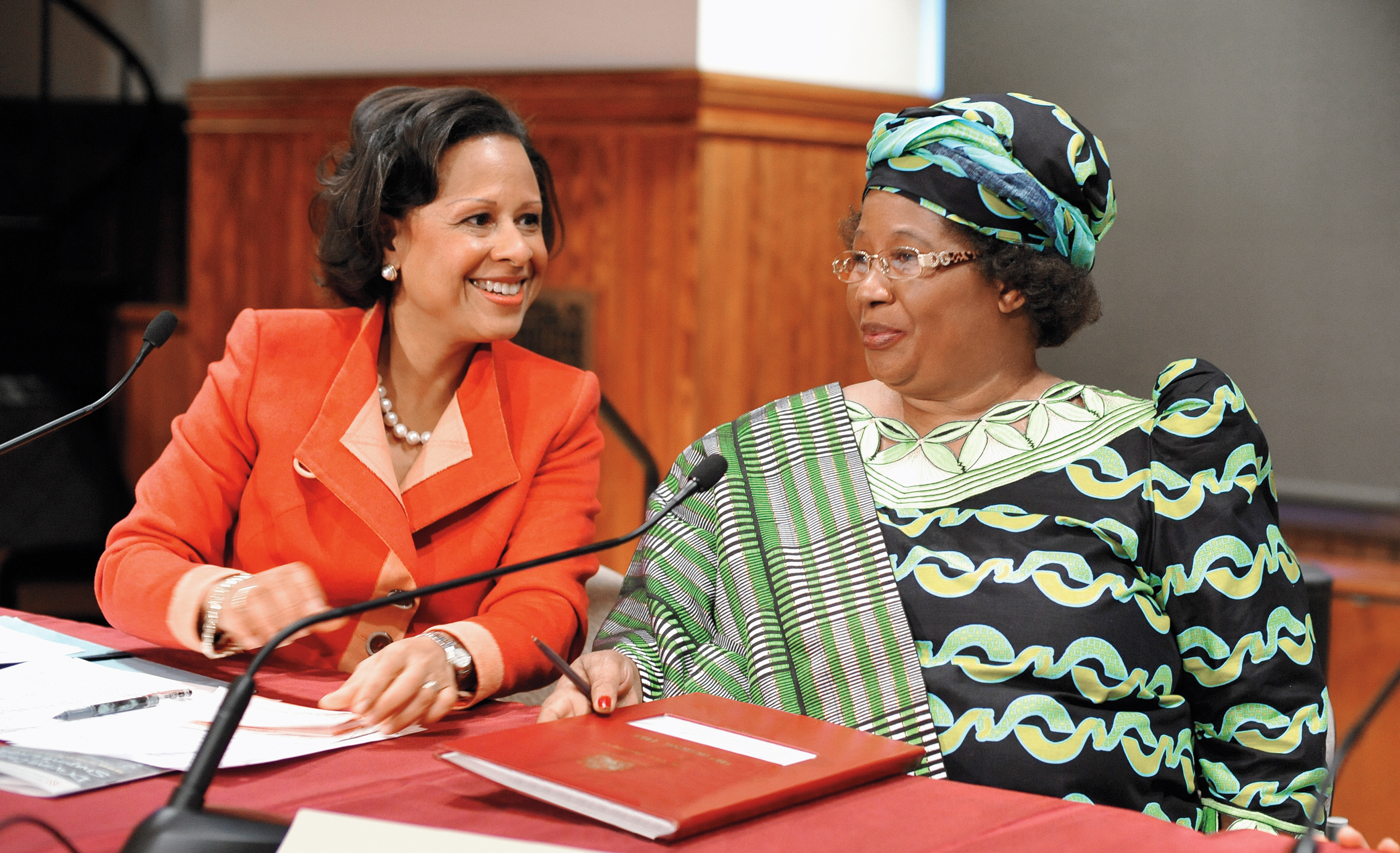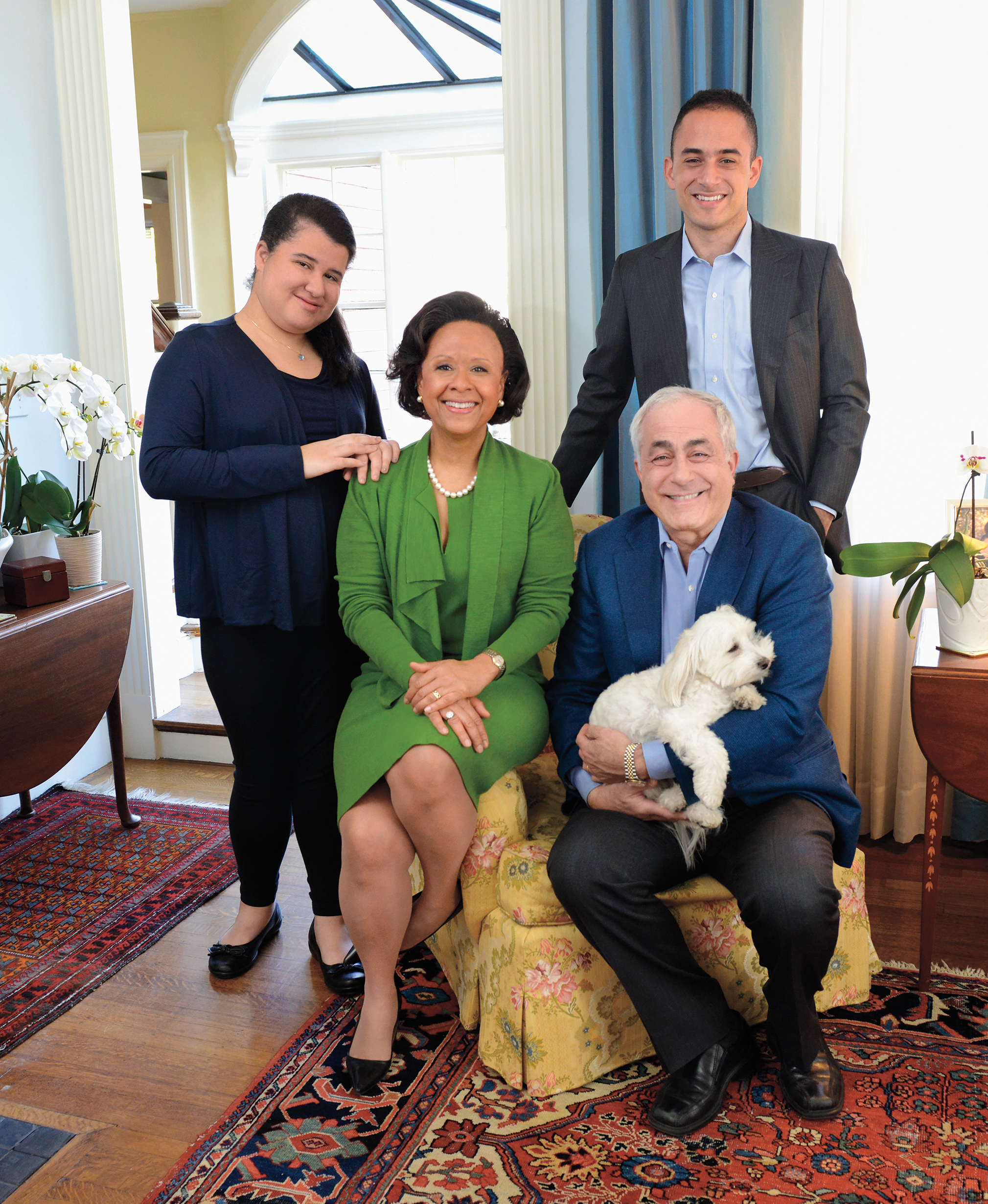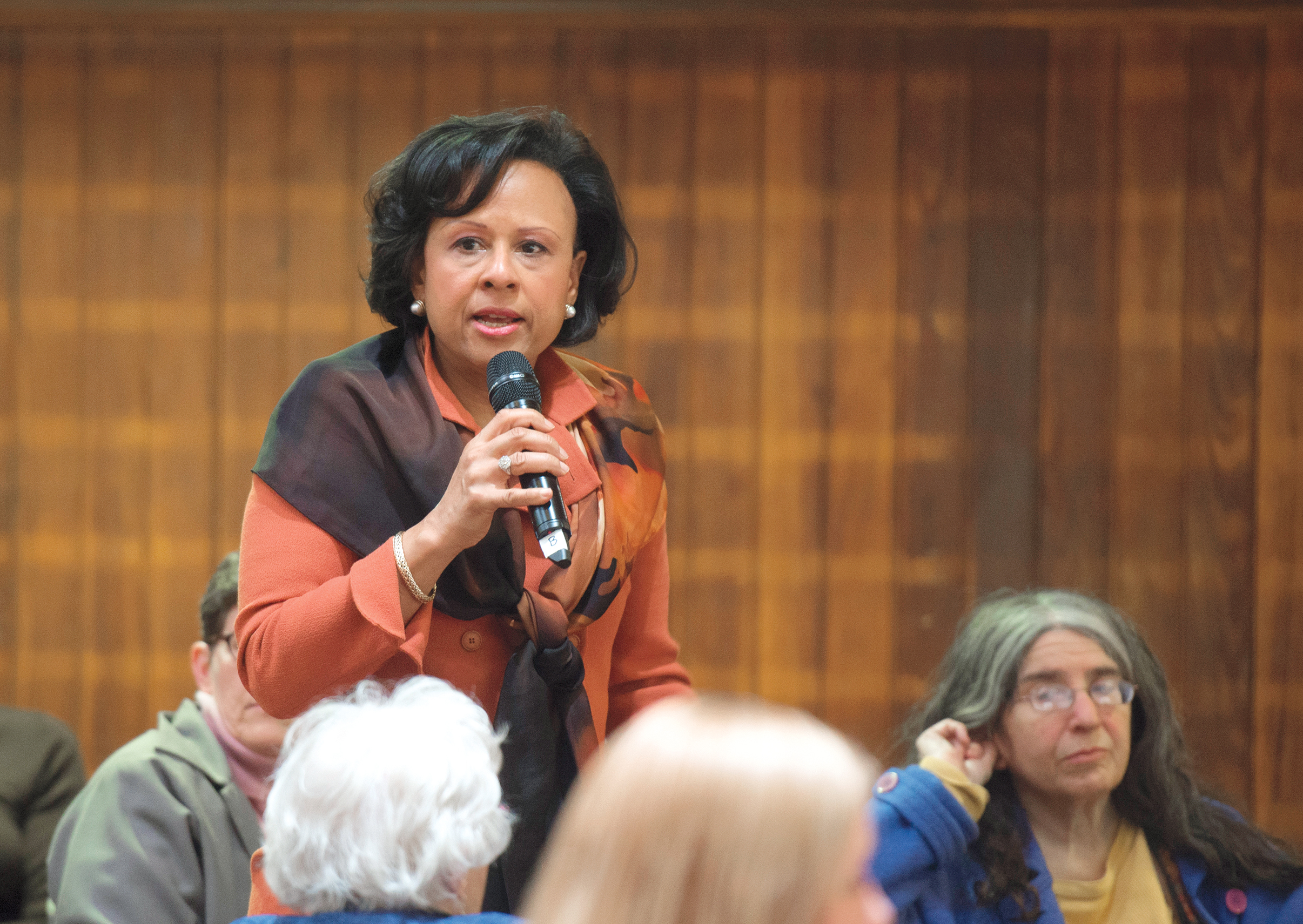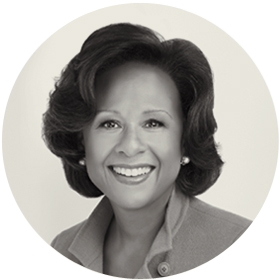As a physician, researcher, and public-health expert, Paula A. Johnson has insisted on taking the broad view when it comes to women’s health, considering the entire woman, not just part of her. As she takes the helm as Wellesley’s 14th president, Johnson brings her passion for improving the lives of women—and for transforming the world.
Thursday, Feb. 11, was a typically frenetic morning at Paula A. Johnson’s home in Brookline, Mass., a beautiful Victorian house where her family has lived for almost 25 years. Her 15-year-old daughter, Kate, was rushing to get to high school. Her husband, Robert Sands, head of rheumatology at Harvard Vanguard Medical Associates, was also hurrying out the door. And their 2-year-old Havanese, a white ball of canine fluff named Buddy, was in the mix and underfoot.
But in one very notable way, it was not a usual morning for Johnson. She was not heading to work at Boston’s Brigham and Women’s Hospital, where she served as executive director of the Connors Center for Women’s Health and Gender Biology and chief of the Division of Women’s Health (a joint appointment at Harvard Medical School). She was not preparing for a class at the medical school or Harvard T.H. Chan School of Public Health, where she was a professor. Instead, Johnson was getting ready to drive in the other direction down Route 9, to Wellesley, where she would shortly be announced as the College’s 14th president.
Meanwhile, at about the same time on campus in Pomeroy Hall, Charlotte Harris ’16, a student member of the presidential search committee, was watching the clock in the Pom dining room. At 9:02 a.m., she stood up and made a public-service announcement. “I said, ‘Everyone, stop eating. Check your emails. At 4 p.m., go to Alumnae Hall,’” Harris remembers. She and Shivani Kuckreja ’16, the other student on the search committee, had been bursting with excitement about the decision and couldn’t wait for Wellesley to share in their joy.
After the campus community and the alumnae body had been emailed with the news, Johnson began making phone calls. “As I talked to people, I said, ‘It’s Paula Johnson from Wellesley.’ And it was the most amazing feeling, and it felt just right,” she recalls.
That afternoon in Diana Chapman Walsh Alumnae Hall, members of the Wellesley community crowded into the main auditorium, eager to meet Johnson, an internationally recognized educator, researcher, and expert in health care, public health, and health policy—and the College’s first African American president. “A lot of professors actually let their classes out early so that students could attend that announcement or reception or both, which is really great. It just speaks to the Wellesley community. … It’s really a once-in-a-lifetime chance to witness this as a student,” says Kuckreja.
‘We wanted somebody who not only had an enthusiasm for Wellesley, but was aligned with Wellesley’s mission, a commitment to liberal-arts education in a residential community of women. We wanted somebody who had appreciation and respect for what Wellesley is, but also had aspirations and ideas for Wellesley’s future, for how to sustain Wellesley’s excellence and make it even better.’
—Debora de Hoyos ’75, Wellesley trustee and chair of the presidential search committee
The atmosphere in the auditorium was electric when the chair of the board of trustees, Laura Daignault Gates ’72, the members of the search committee, and Johnson herself walked onto the stage to a standing ovation. Johnson held both her hands over her heart in a gesture of gratitude. In her remarks, she noted, “This is such an amazingly important moment in time for women and for women’s leadership. Finally, women’s leadership is being recognized as transforming health, education, and economies. The economies of families, cities, and whole countries. But we also know that gaps remain. And we also know that there is a growing inequity in our society, in our world, and women bear a disproportionate burden of that inequity. So here is the opportunity, but herein is the need. And this, in my opinion, is what makes Wellesley so relevant and so hopeful in terms of transforming the future.”
Looking back on that afternoon, Johnson says, “I just felt embraced by this remarkable community. And I will tell you, standing up there, I learned quickly how Wellesley tells you they like something. It’s the snapping of fingers. … It was so wonderful.”
According to those who know her well, Johnson is a quick learner. Throughout her career in medicine, public health, and public policy, as well in her extensive work on boards of local and national organizations, Johnson has had a knack for asking the right questions, listening carefully, and then unifying disparate constituencies around a shared vision. And, as those who heard her remarks in Alumnae Hall that February day can attest, she is a charismatic speaker. She also connects with people one-on-one. At the reception in the Alumnae Hall ballroom after her remarks, Johnson spoke with many members of the community individually.
“We had planned it so that she would only have to speak to each person for a short amount of time,” says Kuckreja. “But Dr. Johnson insisted that she wanted to meet every single person and have the conversation with the person that they wanted to have. And so, I think that really speaks to the fact that she’s really going to make time for everyone. She’s going to make it happen.”
‘Paula Johnson stood out in a very strong pool of candidates. She has a deep understanding of and commitment to the mission of Wellesley. She clearly communicated to the entire search committee and board her firm belief in the importance of Wellesley today. She inspired us with her vision of the contributions that Wellesley and Wellesley women can make to our complex world. And finally, she has the leadership experience and skills Wellesley needs to capture the opportunities before us.’
—Laura Daignault Gates ’72, chair of the Wellesley College Board of Trustees
Brooklyn Beginnings
Johnson grew up in Brooklyn, N.Y., on the “nonfancy side of Prospect Park,” in a warm and loving home with her parents and younger sister. Her grandmother lived in an apartment behind their four-family home. Her father was a printer, and, Johnson says, “back then, blacks could not get into the union, so he worked mainly in non-union shops.” Her mother stayed at home with the two girls, and later worked as a school secretary. Very engaged in the schools, her mother focused on finding the best public school for her daughters. “So I switched around schools a few times, but ended up in what was really an excellent elementary school, and moved on through the public-school system,” Johnson says.
But her education wasn’t limited to time in the classroom. On weekends and vacations, her mother would take her daughters around New York City, exploring its parks and museums and buying discount theater tickets at the TKTS booth. “She was a very resilient person and loved life. She really did not have a lot of opportunity in her own life,” Johnson says. “She grew up in poverty. But she wanted to ensure that her children were independent, critical thinkers, and had the ability to achieve whatever they wanted to achieve without that being a dictated path.”
Her mother, whose education had ended when she graduated from high school, dreamed of getting her bachelor’s degree at a liberal-arts college. One year after Johnson finished medical school, her mother achieved that dream. “She was not going to college for a new career. She was going for the pure joy and privilege of learning,” she says. “That left a very important mark on my sister and myself. … What is the love of learning, and how do we continue that, even if there isn’t a specific end in mind? It is about nurturing the soul and living as an active, engaged person.”
Johnson herself went to Harvard Radcliffe Colleges as an undergraduate. The class of 1980 was one of the first to be selected through a joint admissions process between the two schools. “Radcliffe still had a presence as a place of convening and support for women, and a rich history,” Johnson says. She had a wonderful experience there, realizing how much she could learn from her peers, as well as from professors and books.
Even before she arrived in Cambridge, Mass., though, she knew that she wanted to be a physician. She was attracted by the combination of the “challenge of science and the altruism of helping people,” she says. At Harvard, Ruth Hubbard, the first woman to hold a tenured professorship in biology, sparked Johnson’s passion for women’s health. There was also a very personal reason that the subject interested her: When Johnson was 8, her beloved grandmother experienced a deep, life-altering depression from which she never recovered. These two women set Johnson on the path to understanding how illnesses affect people differently based on their sex.
‘What I witnessed with her over the years in her leadership of the Connors Center was that her concern was never so much about herself or her reputation, but it was always what she could do to support and advance the careers of the young women and men who worked under her, to make sure they were getting the opportunities they needed, the recognition they deserved.’
—Vivian Pinn ’62, former director of the Office of Research on Women’s Health at the National Institutes of Heath
Center Of Change
After earning both her M.D. and M.P.H. at Harvard, she did her residency at Brigham and Women’s Hospital, specializing in cardiology. In 1990, she was made chief medical resident, the first African American to hold the position there. In that role, Johnson worked with more than 100 medical students and residents, and was determined not just to instruct them, but to work with them to improve the training experience itself.
In 2002, Johnson became the founder and executive director of the Mary Horrigan Connors Center for Women’s Health and Gender Biology. The mission of the Connors Center is nothing less than to transform medicine so that sex and gender are routinely considered in the medical care of women. This lofty mission has many parts: conducting research, improving clinical services and patient care, training students to think differently about the way medicine is done, and influencing women’s health policy. The Connors Center has, for example, contributed to the understanding of how women experience stress differently in the brain, and how that might be connected to higher rates of depression in women.
Equally as important as the research, says Johnson, is the work the Connors Center does translating it into clinical care for women. In 2005, it founded the Fish Center for Women’s Health, an interdisciplinary, multispecialty practice that supports, in particular, the areas of health in which women have been traditionally underdiagnosed, undertreated, or underserved. “[We] focus on the whole woman, not just on various systems individually,” Johnson says. “We know that if a woman has a heart attack, that if she’s depressed, which she’s more likely to be, her risk of a second heart attack is significantly higher than a man if he is depressed. As a cardiologist, it’s inadequate for me to just purely think about the heart. I really have to be thinking about that woman’s psychological state and ensure that we have the ability to care for her, not only in terms of her physical health, but in terms of her mental health.”
One of the Connors Center’s recent accomplishments that Johnson is most proud of is in the area of public policy. The center examined the field of women’s health, and how far it had come—or, as it turns out, had not come—since Congress passed the National Institutes of Health (NIH) Revitalization Act of 1993, which mandated that late-stage NIH-funded clinical trials include women and minorities. The Connors Center found that after more than 20 years, significant disparities remained, and there was still a considerable deficit in research to improve women’s health.
This research moved Congress to request a report from the Government Accountability Office. “What the report showed was that the NIH had really not lived up to the spirit of the law, and with that report, the NIH changed its policy,” Johnson says. Among the changes: the NIH would start requiring the inclusion of adequate numbers of women in all phases of clinical trials, as well as the inclusion of female animals and cells in research. It would also require the reporting of data by sex.
The broad view that Johnson takes is rare in academic medicine, says Lydia Pace, a physician in the Division of Women’s Health at Brigham and Women’s and a mentee of Johnson’s. “In academic medicine, in general, people get recognized for being extremely specialized, and the narrower your area that you work on, the deeper you gain expertise. And Paula has somehow been able to do the opposite. … I think she is able to lead across such a range of domains and disciplines, which I think is exactly what women’s health needs, and I think it also makes a liberal-arts environment really perfect for her,” Pace says.

Johnson with Joyce Banda, president of Malawi from 2012 to 2014, at a panel discussion on gender in the developing world at the Radcliffe Institute for Advanced Study in 2011.
Photo by Tony Rinaldo Photography

Paula Johnson at her Brookline, Mass., home with her children, Kate and Jonathan, and her husband, Robert Sands, holding Buddy, a Havanese.

Johnson moderates a panel discussion at an April 2014 conference at the Radcliffe Institute for Advanced Study, “Who Decides? Gender, Medicine, and the Public’s Health”
Photo by Tony Rinaldo Photography
The Classroom and Beyond
Teaching has been a big part of Johnson’s career—teaching one-on-one, teaching as a mentor, teaching in a clinical setting, and, as she says, “teaching with a big T, which is teaching classes.”
One of Johnson’s favorite classes to teach was a seminar she developed that examined the models of leadership that have improved the health of women around the world. The class, which Johnson taught three times, included students from Harvard’s medical school, the school of public health, and the Graduate School of Arts and Sciences. She delighted in the diversity of perspectives, and tackling a subject that has not been studied extensively before. “The material is new. There is nothing written, really, about leadership models to advance women’s health. So you’re studying what has actually improved the health of women, how that has been done, and how might we develop ways to model education and training in order for that to happen,” she says.
The course was structured around writing case studies of leadership models that have proven successful. One of the cases her colleagues wrote was on alumna Adrienne Germain ’69, president emerita of the International Women’s Health Coalition, who has devoted her life to advancing women’s reproductive health. “Her model is one of shared leadership,” Johnson says. Another example is the Self Employed Women’s Association (SEWA) in India, a trade union of self-employed women that was founded in 1971 and has expanded to become a social-services agency.
That course, and Johnson’s work in women’s health in general, illustrates her liberal-arts approach to problem solving. Studying women’s health involves clinical research—which must be done through a gendered lens—as well as social sciences, environmental sciences, sociology, anthropology, and economics. “All these disciplines are so critical to understanding what does or does not produce health. And we still don’t understand fully,” Johnson says.
An Inclusive Leader
Through the years, Johnson has devoted a significant amount of time to serving on boards, as well as holding leadership positions in local and national organizations. She has served as an overseer or on the boards of the Isabella Stewart Gardner Museum, Planned Parenthood Federation of America, the Museum of Science in Boston, and WGBH, Boston’s public television station, to name just a few. Also, notably, she has served on the Boston Public Health Commission since 2007.
“Working on the board of the Boston Public Health Commission, and then as the board chair, has made a really indelible mark on my belief in what strong teams and coalitions can achieve,” Johnson says. She points to a number of regulations on tobacco that were enacted while she was on the board—everything from inhibit-ing sales on college campuses and within a certain radius of schools to limiting smoking in public parks to, most recently, raising the age at which people can buy tobacco products in the city of Boston to 21.
Along with the successes, Johnson has served on boards during great crises and tragedies. She was chair of the board of the Boston Public Health Commission during the 2013 Boston Marathon bombing, and in 2014 when city officials abruptly closed the shelter on Long Island in Boston Harbor, leaving hundreds of homeless people without shelter and services. “Rallying and creating quick solutions, dealing with the physical and emotional aftermath [of these events], it was all made possible because of those strong relationships and that strong coalition,” Johnson says.
In all of Johnson’s leadership roles—on boards, at the Connors Center, at Harvard—she has kept the mission of the organization she’s serving front and center. “Leading with the mission, and also leading with respect for others’ voices, and with kindness and empathy” has always been her goal, she says. “Being an active listener … really allows you to hear the voices in order to create that shared vision,” she says.
‘Paula has always been a very big thinker. She’s taken on this issue of women’s health as a global issue. She’s very familiar with the sort of social and economic challenges facing women … [that] there’s still a lot of room for improvement in all levels of society for women as leaders. That intersection between women’s progress and the role that Wellesley College can play will be very apparent. She’ll be able to bring lots of people together to forge a vision for how Wellesley can think bigger in the future.’
—JudyAnn Rollins Bigby ’73, former Massachusetts secretary of health and human services and current Wellesley trustee
Lydia Pace at Brigham and Women’s, who first started working with Johnson as a Global Women’s Health Fellow at the Connors Center, adds that Johnson leads with incredible warmth, and has an amazing ability to connect with people on a personal level. “I’ve had two babies since I started the fellowship, and I think she was about the second or third person that I told I was pregnant, period, both times. … She just makes you feel very safe, while acknowledging the challenges. … I think being able to come into a meeting with that degree of honesty lays a good foundation for really effective problem solving, and she’s just really incredible at recognizing the reality of people’s lives, and figuring out how to make things work,” she says.
Johnson at Home
With such a busy life, how does Johnson relax? “My family and my friends are sustaining. I just can’t tell you how important those relationships have been in my life,” she says. Some of her favorite moments with her family—her husband, daughter Kate, and son Jonathan, who just finished his junior year at Harvard—are at home, cooking. (Osso buco is a family favorite.) When she talks about managing her busy career and family life, Johnson doesn’t like to use the word “balance,” which implies that there is an achievable, perfect moment where the scales are aligned. “I like to use the word integration, because I think it’s a much more dynamic word. Each and every day, we are integrating our lives with work. And you know, for some of us, it’s parenting. For some, it’s care of ill parents. It can be following a lifelong pursuit that you’ve wanted to do that is not your day job. … For us to think there is some absolute balance that one achieves, and then it’s a steady state, I don’t think we do ourselves—or other women, or men—a favor. And thinking about this process of integration also allows us to have a certain level of flexibility and resilience that allows us to achieve goals that we might not have even assumed we could achieve.”
Challenges Ahead
Charlotte Harris ’16 and Shivani Kuckreja ’16, the two students on the presidential search committee, agree that two of the biggest issues the student body is hoping the new president will address are mental health and wellness, and issues of diversity and equity. “That was just something that we’ve seen over our four years here, that students have been constantly wanting more resources, wanting more discussions [about mental health and wellness]. We also wanted the candidates to talk about diversity, and how we can make our campus more inclusive,” Harris says.
Johnson thinks that Wellesley should continue to think about how to address students’ physical and mental health, “which really sets them on a path of a healthy mind and a healthy body, and being prepared to meet the world’s challenges, and to make that difference in the world.” It’s a critical issue, she says, especially at a women’s college. “We know that women are far more likely to experience depression and anxiety. And we know that many young women are walking in our doors with chronic illness. And we also know from our research on sex differences in health and disease that women engaged in certain activities, like sports, for example, are more likely to experience concussions.” She says she doesn’t have an easy answer to the question of how to address the totality of health and well-being at Wellesley, but she is eager to engage with the issue, along with the student-life department.
When creating a diverse, inclusive community, recruitment of faculty and students of color and those of diverse identities and backgrounds is only the first step, Johnson says. “The other pieces are really around retention. And retention requires ensuring that there’s an inclusive community, requiring that there’s the ability for those from different backgrounds and identities to take advantage of what an academic environment can provide, and ensuring that their mentoring and sponsorship is solid,” she says. When she arrived at Harvard Radcliffe in 1976, an African American woman from a working-class background and the New York City public-school system, as good as her experience was, she was ill-equipped to take advantage of some things at the school. “We have to work to make sure that our students can take advantage of a rich environment like Wellesley … making sure that there is equity in how we enable our students to experience Wellesley,” she says.
Johnson also says that she has learned about the importance of training and conversations about implicit bias—attitudes and stereotypes that affect our judgment and behavior in an unconscious way. “I do think we all have [implicit biases], no matter what background we’re from,” she says. In faculty hiring committees, for example, “The best committees are those where there’s an entrée for open dialogue when we recognize bias occurring. It’s not a static thing—you go through training, and now you’re trained up. How do we keep that dialogue alive? … You have to create an environment in which there is enough openness to have those discussions, and to have enough trust in your colleagues that they’re going to be able to hear it. … And leaders have to set that tone.”
Johnson also recognizes the significance of being an African American woman in a leadership position. “Your presence is important, as an African American woman,” she says. “I was the first African American professor at Brigham and Women’s. This achievement allowed others to understand what is possible.”
‘Everything is unique about [Paula’s] approach. The way she has brought leadership together, the way she brings supporters of this work together, the way she cares deeply about the patients, the way she mentors physicians. … Her capacity to see all of those pieces as a whole and address them well is very unusual and will be so well translated to Wellesley.’
—Ophelia Dahl CE/DS ’94, co-founder of Partners In Health and its current board chair
But it’s also important, she says, to “talk about your journey, to talk about the fact that it hasn’t been a straight trajectory from one end to another, to talk about times when you didn’t achieve what you wanted to achieve, and what you learned from the experience.” Young people from all backgrounds tend to think that successful people have never experienced failure, she says. “But I think this perception may be more intense for those who are from minority groups or less-represented backgrounds. They tend not to understand that failure has often been an important part of the picture when someone is in a position of leadership. And I think it’s really incumbent upon us to share.”
Learning the Wellesley Way
When Johnson heard all those students snapping in Alumnae Hall in February, she realized there is a lot about Wellesley she’s going to have to learn. She’s planning on starting with the people. “Very simply, I am going to have to really spend time getting to know the students, the faculty, the staff, the board of trustees whom I report to, and the amazing network of alumnae. And I think it’s going to be very important for me to hear from people from all these constituencies. What are their hopes and dreams for Wellesley? What do they see as the major challenges for Wellesley?”
Johnson also plans to look to her predecessors—presidents Nan Overholser Keohane ’61, Diana Chapman Walsh ’66, and H. Kim Bottomly. She is eager to learn the history, too—both by reading it, and by hearing stories from members of the community. “I think having a deep appreciation of the history of Wellesley—all of the history, in various periods—is so important to how we move forward. What’s worked, what’s failed, where we’ve moved things forward, where we haven’t,” she says.
Johnson expects that a lot of her Wellesley education will happen as she becomes a part of the day-to-day community. “My 15-year-old, who’s a freshman in high school, is thrilled to have an opportunity to eat in a dining hall and attend athletic events,” Johnson says.
She is looking forward to getting to know the campus itself, with which she already has a connection. “I have a very close feeling to this campus because it was designed by Frederick Law Olmsted, and he’s played a very important role throughout my life,” she says. She grew up on the edge of Prospect Park, which she took advantage of throughout her childhood years, as well as Central Park in Manhattan. And for most of her adulthood, she’s lived along the Emerald Necklace in her Brookline home. So living on campus feels like “the next stop with Frederick Law Olmsted,” she says, laughing.
Right from the start, Wellesley felt like home.
 Lisa Scanlon Mogolov ’99 is a senior associate editor at Wellesley magazine.
Lisa Scanlon Mogolov ’99 is a senior associate editor at Wellesley magazine.








We ask that those who engage in Wellesley magazine's online community act with honesty, integrity, and respect. (Remember the honor code, alums?) We reserve the right to remove comments by impersonators or comments that are not civil and relevant to the subject at hand. By posting here, you are permitting Wellesley magazine to edit and republish your comment in all media. Please remember that all posts are public.